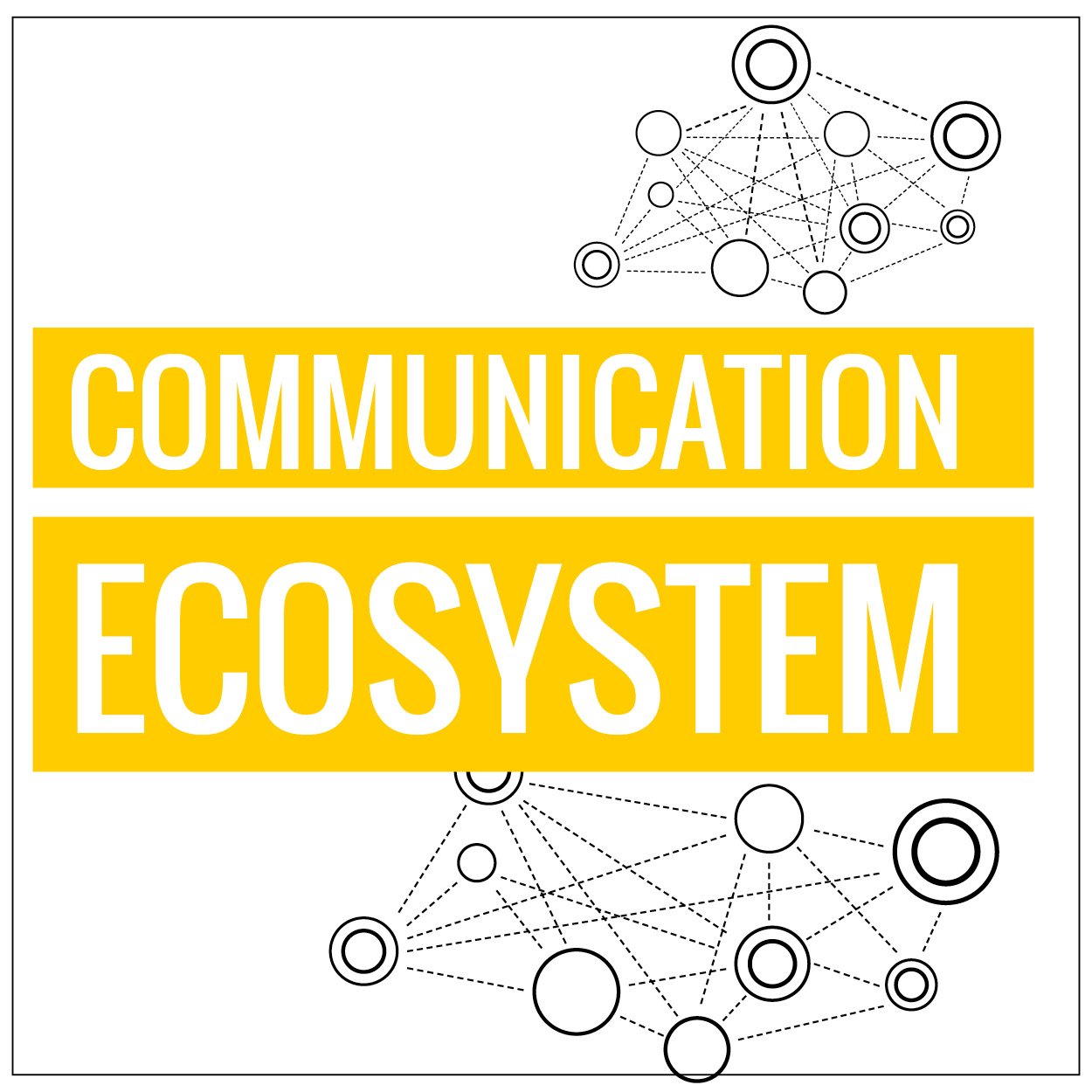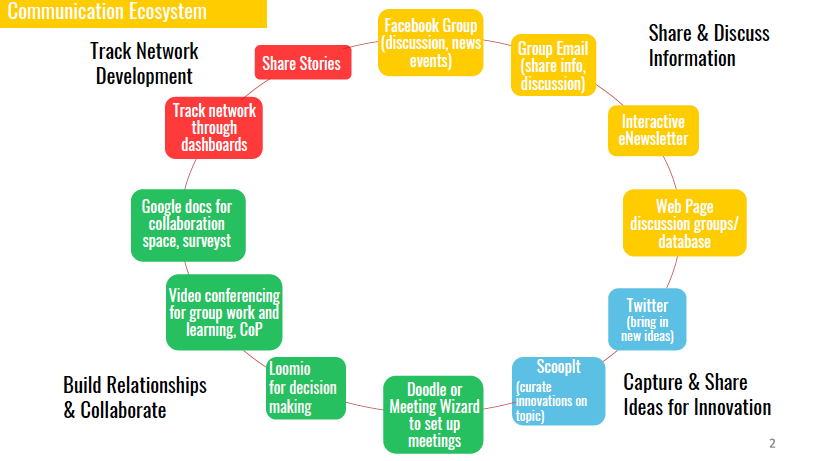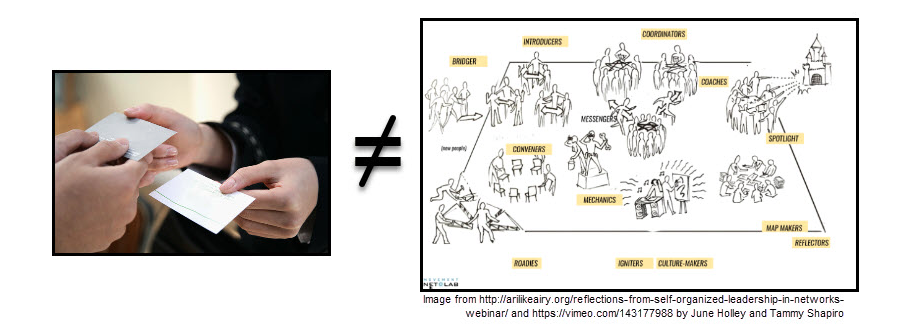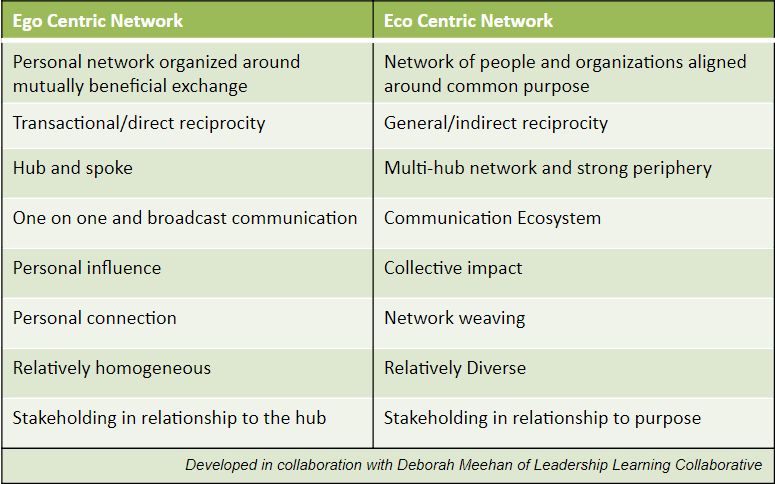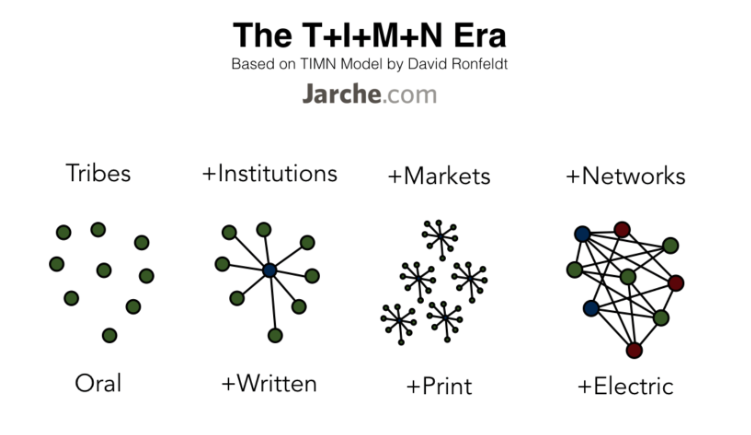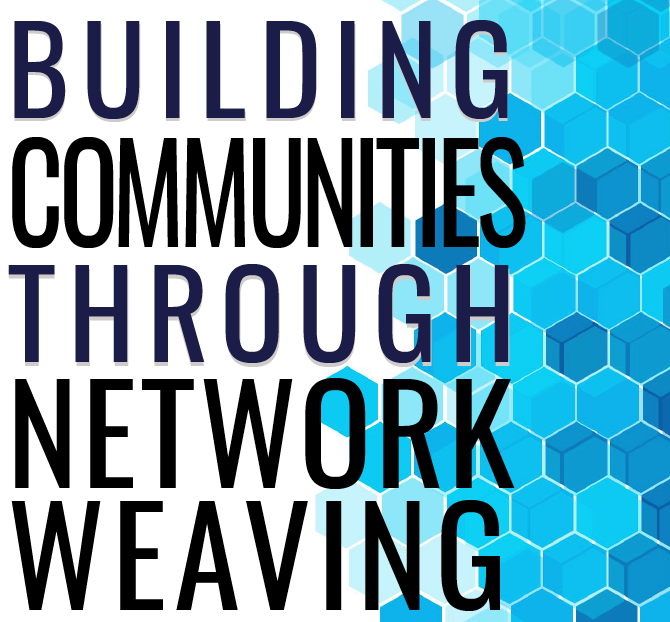What Is Self Organizing?
Self-organizing is perhaps the most important and least understood aspect of System Shifting Networks.
There are many scientific definitions of self-organizing but they are hard to wade through. After 20 years of helping networks self-organize, I’ve created a definition that is very concrete and practical for getting started with self-organizing.[ap_spacing spacing_height="10px"]
Self-organizing happens when any individual or group...[ap_spacing spacing_height="15px"]
- sees an opportunity to make a change or try something out (idea or opportunity isn’t dictated by anyone else)[ap_spacing spacing_height="20px"]
- feels like they can initiate action (self-generated idea and action)[ap_spacing spacing_height="20px"]
- finds diverse others from a large network to join with them or collaborate (those who work on the project aren’t dictated by anyone else, people self-select to participate)[ap_spacing spacing_height="20px"]
- experiments with small actions[ap_spacing spacing_height="20px"]
- accesses the (usually small) resources they need to act[ap_spacing spacing_height="20px"]
- spends a lot of time paying attention to what is happening, debriefing, learning from the experience, and analyzing what they did -- all to enable them to take a better next step[ap_spacing spacing_height="20px"]
- shares what is learned with the larger network [ap_spacing spacing_height="25px"]
A self-organized project has an end - when it ends, all the participants can decide if they want to work with others on their next project or not.
Self-organizing becomes transformative when there are thousands of such projects in a network, and each individual is involved in a number of projects, so that innovations and new ways of looking at problems spread rapidly throughout the network, enabling each new project to be more effective. The spread of the use of zoom.us videoconferencing platform by networks over the last two years is an example of how innovations can spread from project to project virally.
Self-organizing is based on the assumption that we don’t know how to solve most of the problems we are trying to solve. Self-organized projects probe the problem, helping us learn more about it and how to best shift the system that is generating the problem.
Another transformative aspect of self-organizing occurs when participants in self-organized projects come together in communities of practice to share what they have learned from their project, support each other with challenges, and discuss how they can apply what they have learned to future projects. When this is shared with the larger network everyone can benefit.
Here is an excellent video of Tamara Shapiro of Movement Netlab on a Leadership Learning Community (LLC) webinar on Self-organizing in Occupy Sandy. Highly recommended!
Friday, Network Weaver will be posting the Self-organizing Toolkit, which you will be able to download for free in the resources section.
In the coming weeks we will outline the simple steps you can take to jumpstart self-organizing in your network.
How have you experimented with self-organizing in your networks? Please share in the comments section below.
June Holley
Communication Ecosystem
A new downloadable free item is up on the Network Weaver Resources page.[ap_spacing spacing_height="20px"]
One of the most critical support structures for networks is a well-thought out communications ecosystem - a set of tools and platforms that enable everyone in the network to connect and collaborate directly with anyone else in the network.
This kind of communication system is quite different from the broadcast strategy of many organizations, where the organization sends out information via a newsletter and/or website but has no avenues for people to respond or build connections to each other.
A communication system that supports interaction among network participants needs to fill four functions:
- Provide spaces and places for discussing ideas and for sharing what has been learned. [ap_spacing spacing_height="15px"]
- Ensure that everyone has access to new ideas and innovations from other communities and networks.[ap_spacing spacing_height="15px"]
- Many places for network participants to get to know each other and deepen relationships, and to work together collaboratively.[ap_spacing spacing_height="15px"]
- Ways to track network development (network leadership, network values, collaboration and collaborative skills, stages of network development, development of network support structures, network stories, etc) and use this data to enable the network to move more rapidly to a system shifting networks. [ap_spacing spacing_height="15px"]
[ap_spacing spacing_height="15px"]You can use the free handout in the Resources section to engage participants in your network in a process to help co-design your network's communication ecosystem. Share the handout with any network participants who are interested and begin to fill out the page with blank boxes
NENAD MALJKOVIC
CLICK HERE to download Communication Ecosystem handout.
Why Networks?
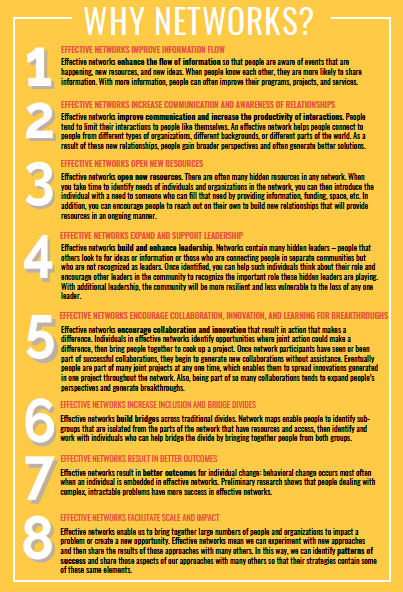
Many people are asked "Why networks?" or "When does it make sense to use a network approach?"
This handout explains all and makes it easy for you to email to someone with a response.
Why Networks? is newly added to our RESOURCES page… and it’s FREE!
To download, CLICK HERE.
Network-ing Does Not Equal Network WEAVING
Those of us who work with change networks could sometimes do a better job of clarifying the distinction between 'networking' and 'network weaving'. Leaving that distinction un-articulated and merely implied inclines those who are new to the discussion to default their hearing to the generic-mainstream meaning of 'networking'. It leaves much of what is important and different about network weaving either un-said, un-heard, mis-understood, or suspect.
Now don't get me wrong - generic 'networking' is indisputably important. Contrasting something to it doesn't mean devaluing it.
And in reality, there's a world of overlap. Either can merge into becoming the other. You could personally be doing one, in the context of the other. And what you think you're looking at depends on where you fit in the network. There isn’t a bright line. My pretense at precise distinction is merely for the sake of nudging us a little further along the spectrum of what's possible.
Because - there's more power and potential in a social network than we've been taught & have grown accustomed to recognizing. And it's hard to access that 'more', if our words limit our imagination. So this is as much about what we're IMAGINING we're doing while we're doing it, as it is about precisely WHAT we're doing.
For those of us who don't resonate to Harvey McKay's 'Swim With the Sharks' and that ilk - the default, mainstream meaning of 'networking' can be a big turn-off . We've come to understand it as a specific, often self-serving, not-necessarily-authentic, social butterflying kind of activity. To many of us 'networking' is a popularity contest - best left to smarmy salesmen, politicians, corporate CEOs & lobbyists. We get a little queasy just contemplating joining those ranks. And no amount of rosy pep-talk convinces us. For introverts and those who value authenticity ‘Networking’ fires up the wrong imaginings.
But beyond being a potential turn-off, the common usage of the word falls short of the vision and purpose behind network weaving. 'Networking' tells the social butterflies they've arrived (an assessment the rest of us can’t agree with), while it leaves much of a network's deeper potential impact and generativity untapped.
We need different words to signal that we're leaving the default meaning behind and talking about something more. And we have them, we just need to use them.
[ap_spacing spacing_height="20px"]A DIFFERENCE RECOGNIZED BY SOCIAL NETWORK SCIENTISTS
Social network scientists have some technical terms that can help us explore this distinction. Terms for different ways of focusing on, or 'scoping' a network for analysis. They are 'ego-networks', 'socio-networks', 'open-networks', and 'eco-networks'.*
I'll say more about 'ego-networks' and 'eco-networks' in a moment, but for the curious, I'll just say this about the other two:
A 'socio-network' is a 'network in a box'. It has clearly-defined, solid boundaries - such as “everyone who works at Company X”, “or everyone who goes to School A” - it only looks at the relationships existing within that boundary - no-one else is relevant.
An 'open-network' is what it sounds like - there are no boundaries. The internet is an open network. Twitter is an open network, Facebook is an open network - anyone can open an account and anyone can be connected to anyone. There is no limit to who might be included in a network map of an open network. In theory, it includes the entire human race (or even further).
*From Understanding Social Networks: Theories, concepts and findings by Charles Kadushin
[ap_spacing spacing_height="20px"]NETWORKING IS TO NETWORK WEAVING WHAT EGO-CENTRIC IS TO ECO-CENTRIC
For our discussion here, the more interesting technical terms are 'ego-network' and 'eco-network', which fit the distinction I'm trying to make almost perfectly. So let's dig in:
An Ego-Network revolves around a core person - it is defined by direct relationships to that central person and doesn't include indirect (2nd degree) relationships or persons unknown to the core person. Sounds a lot like what we get from 'networking', right? It's all about 'me'.
[ap_spacing spacing_height="15px"]What's an Ego-Network?
On a network map it looks like a hub with spokes. The relevant connections are to the single node at the center.
In our society, an ego network is generally connected around support of the core person in some way - important career contacts; the politicians a lobbyist cultivates; the network of family, friends and caregivers around someone with a severe illness, or something like the child support network I was gifted with as a young single mom, made up of sage advisors, friends who babysat regularly (or with whom I swapped regular babysitting) so I could work, friends who would drop everything to come get the kid if I had an emergency, and the kid's dad who gave me big chunks of time off. In that case, the connection to me (and the kid) was what was relevant - whether or not any of them knew one another didn't really matter. There was no larger purpose than helping me out or enjoying my kid.
This is the type of network that 'networking' tries to build and leverage. It is often based on direct reciprocity (I scratch your back, you scratch mine), is personally maintained (I work to maintain the relationship - stay in touch, send gifts, etc.), and often requires a direct match between my needs & yours - if there’s no direct match, there’s no relationship. (i.e. if you can’t help me raise my kid, I have far less reason to sustain our relationship, given my limited time and energy). And it's often homophilic ('like attracting to like') or relatively homogenous. My kid-network consisted entirely of older-moms, current-moms, wanna-be moms & one dad.
And because of their relative homogeneity, ego-Networks can easily become echo-chambers.
If the hub of an ego-network goes away the network falls apart. In an ego-network, the person is the purpose, and without that person, the connections are gone. My marriage (wonderful as it is), ended a lovely phase of networked connectedness in my life, because the purpose of our interactions (my need for help with child-raising) ended and the network drifted apart.
[ap_spacing spacing_height="15px"]Eco-Networks Fit Between Socio-networks & Open Networks
An Eco-Network is a relative newcomer to the network-science labelling game. I don't even know where I got the term from. It's not in the book I pulled the others from, which is what I'd expected. I know I've come across it in a few places over the course of my network reading but haven't been able to re-find them - so if anyone reading this can find them, please share with us!
In any case, an eco-network sits somewhere between a socio-network and an open-network. A socio-network (the 'network in a box') generally has a centrally defined, narrow purpose (think 'mission statement' or 'avoiding organizational bankruptcy'); a clear & precise definition of inclusion (think 'everyone on our payroll' or 'the roll-call list'); a relatively centralized & hierarchical command system; and officially-sanctioned & controlled information and resource flows (balanced by secret, un-sanctioned information flows). Whereas an open network is unbounded, random, directionless and incoherent (think Twitter, FaceBook, Instagram).
So we could think of an eco-network as skirting the boundary between rigid pseudo-control and a free-for-all. In my mind, an eco-network is the social equivalent of that strange attractor within a system that generates ordered patterns out of chaos. To me, an eco-network has the potential to generate a collective path from our current world - a world presently oscillating between destructive authoritarian rigidity and chaotic collapse - to a new world, built on an evolved understanding of order/structure, connection, and thriving.
[ap_spacing spacing_height="15px"]What IS an Eco-Network?
But what does all that MEAN, practically speaking?
Well, it helps to think about ecosystems. For one thing, both eco-networks and ecosystems only thrive with ample diversity.
For another - in both cases, flows of resources (whether money, information, skills, trust and shared inspiration or nutrients, shared environmental context, water and sunshine) are complexly reciprocal, as opposed to transactional. In a forest ecosystem, no-one barters with the squirrel to get it to poop out worm & fungi food. And in exchange for the squirrel poop, worms & fungi don't break the elements down fine enough so that plant roots can absorb them because because the trees or the pooping animals pay them to - they do it because that's what they do, it's part of their organic process. The trees & other plants only grow if there are adequate nutrients and water - and when they do, they create food some of the animals need to survive (and poop out), some of which become food for other animals, and it all requires water, water retention, healthy soil - and so on. There is an organically-driven flow of value, based on adequate diversity, that is not directly transactional.
There is no need for direct transactions because each community member's survival depends on the in-flows (food, etc.) and out-flows (poop, etc.) of all the members. Transactions are too small a dynamic to support the complexity and adaptivity of an ecosystem.
The ecosystem forms an interdependent network of a huge variety of life forms, moving a broad range of nutrients freely through a complex system of flows that sustains the whole thing. Pull out too many parts, or just block up too many of the flows from one component to another and the whole thing collapses. And when I say ‘flows’ here, I mean ‘connection’/’relationship’. You could have all the pieces of the system/network, but if they weren’t able to interact, you wouldn’t have a network, let alone a living system.
In an ecosystem, there is also no 'boss', no centralized command & control. The whole thing works because of how the community fits together, not because someone designed it that way. A social eco-network is similar. There may be players with larger impacts and greater input into direction, but that doesn't mean they master-mind and control the whole thing.
Another thing a social eco-network and a ecosystem have in common is boundaries. They may be fuzzy, but they are real and discernable. For instance, there is diversity, but the diversity isn't infinite (like it could be in an open network) and it certainly isn't random. Whales don't occupy forests, butterflies don't do arctics, polar bears don't co-exist well within rainforests.
With ecosystems the boundary is environmental, the community members all thrive within a similar environment. With an eco-network, the boundary is purpose. And the boundary is what holds the community together.
[ap_spacing spacing_height="15px"]The Point of an Eco-Network
So - ultimately - the main distinction between an ego-network and an eco-network is this - the eco-network exists to support a purpose, not a person or an organization. It supports a broad purpose that is greater than any of the individuals involved, but which benefits all the individuals involved. It's also a purpose which can't be served nearly as effectively by individuals (or individual organizations) acting on their own, without the diverse & reciprocal flows of support and information that characterizes an ecosystem.
The glue, then, is not ONLY strong personal bonds (as in an ego-network) - tho it won't ever work without a lot of them - it is ALSO an intention that is larger than the personal bonds. It is an intention to be one part of a larger, purposeful, whole. An intention to help develop that whole and the individuals within it in ways that are generative for oneself as well as for the larger purpose.
An eco-network, then, has: a purpose; diverse membership; complex reciprocity; multiple 'centers' with multiple roles; and a robust and free flow of information, resources, capacity and care to where they are needed most. A flow that both includes and transcends the bonds of personal connection, and that emerge from the interactions.
Far from being a popularity contest, an eco-network is a puzzle we can do together. It’s a fun but serious game of learning about fits and flows - about how to amplify the impact of what each member has to offer. It’s a dance between the individual and the collective, an ever-shifting experiment with order emerging from chaos.
[ap_spacing spacing_height="15px"]But So What?
Why do I think any of this matters?
I believe it matters because our imaginations matter. All of our actions and behaviors are driven by and reflect our deepest beliefs and values - and these are all gestated in the womb of our imaginations. What we can't imagine, we can't create. And the only way we ever create something new, for which there is no current model, is if we imagine it first. I believe it matters that we pull our imaginations a step past what we already know, do & envision - into a higher level of generative capacity - in a way that affirms and includes everyone, not just the social butterflies.
And I believe that if we tease out a clearer understanding of the values and intent of network weaving, if we tempt our imaginations into this fresh, promising new territory, we go further to affirm and generate the kind of world we want to live in together. We affirm that weaving an impactful and resilient change network:
Is not a contest - it's more about discerning the right network for ourselves (so we don't end up like a polar bear in a rainforest), finding our natural place, supporting the flow of nutrients where they need to go, expressing our unique contribution & helping others do all of that as well.
Means supporting others, whether they're able to support us or not, serves the overall purpose we’re all trying to promote.
Requires a lot of different roles, as well as understanding and appreciating the roles that are different from our own.
Means going beyond developing our own personal relationships, and helping others develop relationships that enhance maximum flow of value throughout the network.
Requires recognizing and acting on the recognition that there is a limit to how much can be accomplished in a transactional context, and that system change is built on an abundance of relationships across differences.
Stimulating this kind of understanding & imagination requires many tools & approaches - Mapping is the tool Tim & I personally contribute to the puzzle. Powerful, adaptive eco-networks are the shift we're trying to support.
What contributions are you interested in making & to which greater purpose? Please join the conversation in the comments section below.
Originally published March 26, 2018 at GreaterThanTheSum.com
Moving (rapidly) to a Network World
[ap_spacing spacing_height="10px"]I’m a network hunter. My idea of fun is to spend hours traveling through the web world, spying new networks and learning all I can about network development.
From my vantage point, the number of networks formed during the last decades has been extraordinary (though sadly no one is tracking this growth so we have no real research verifying the number of existing networks).
Virtually all of us are part of social networking sites, such as Facebook, Twitter and Instagram, and have access to virtual communication channels that open up huge opportunities for people to connect in novel ways.
[ap_spacing spacing_height="20px"]Networks are appearing in every aspect of life:
- Virtually all research is now done through networks of researchers and institutions
- Businesses are forming networks with customers and other businesses, and even organizing internally more as a network (zappos, etc).
- Service organizations are forming networks to streamline referral systems [ap_spacing spacing_height="15px"]
- 20% of married couples now meet on online dating networks
Then there is the particular set of networks that fascinate me (and hopefully you dear reader!). They are all about change. These networks range from those working on some sort of incremental change to those who see their network efforts as transformational, helping us co-create a world that is good for all of us.
[ap_spacing spacing_height="30px"]Types of Transformational Networks
There are many, many different change or transformational networks currently operating. Here are just a few examples:
[ap_spacing spacing_height="15px"]
Sector or Issue Networks
- Environment and sustainability: climate change networks, large landscape conservation networks, transition networks, electric car networks, reuse and upcycling networks, children and nature networks, community solar networks, Fire Learning Network, REAMP [ap_spacing spacing_height="20px"]
- Food: food access networks, local food networks, food policy networks, food hub networks, food business networks, organic food networks, healthy school lunch networks, school garden networks [ap_spacing spacing_height="20px"]
- New Economy: regional economy networks, makerspace networks, sustainable business networks, social capital networks, cooperative networks, networks to support local business, time banks and alternative currency networks,seed exchange networks, FabLabs Network, European Network of Living Labs (ENoLL), Sunday Soup networks[ap_spacing spacing_height="20px"]
- Housing networks: co-housing networks, end homelessness networks, intentional communities networks[ap_spacing spacing_height="20px"]
- Education: early childhood networks, childcare networks, education innovation networks, Flipped Learn Network[ap_spacing spacing_height="20px"]
- Health: health access networks, obesity prevention networks, Self-help networks, self-care networks, cancer-free economy network[ap_spacing spacing_height="20px"]
- Arts Networks[ap_spacing spacing_height="20px"]
- Criminal Justice Networks[ap_spacing spacing_height="20px"]
- Immigrant rights networks[ap_spacing spacing_height="20px"]
[ap_spacing spacing_height="15px"]Cross sector
- Women and Girls: ending violence against women networks, domestic violence networks, girls code networks, end trafficking networks, mom’s rising network[ap_spacing spacing_height="20px"]
- Leadership networks, network leadership networks, network consultants network, Movement NetLab[ap_spacing spacing_height="20px"]
- Gender Networks: LGBT Network,[ap_spacing spacing_height="20px"]
- Communications: open source networks, platform networks, peer to peer networks, community broadband networks, digital for good networks[ap_spacing spacing_height="20px"]
- New politics: new democracy networks, study group networks, community organizing networks,[ap_spacing spacing_height="20px"]
- Movement networks: Occupy Wall Street, Occupy Sandy, #MeToo, Immigrants Rights Movement[ap_spacing spacing_height="20px"]
- Geographic: neighborhood networks, regional environmental networks[ap_spacing spacing_height="20px"]
- Undoing racism and privilege: Racial justice networks, truth-telling networks, sustainable communities networks, ending white privilege networks [ap_spacing spacing_height="20px"]
- Specific cross sector networks: cross sector networks bringing together energy efficient housing groups with low-income housing groups[ap_spacing spacing_height="20px"]
- Advocacy networks: The Advocacy Network on Disabilities, Autistic Self-advocacy Network, Rocky Mountain Immigrant Advocacy Network (RMIAN), Prisoner Advocacy Network Domestic Employers Network[ap_spacing spacing_height="20px"]
- Governance & policy networks[ap_spacing spacing_height="20px"]
- Learning Networks/Communities of Practice: Healthcare breakthrough learning network,[ap_spacing spacing_height="20px"]
- Technology Networks[ap_spacing spacing_height="20px"]
- Philanthropy networks
Pretty amazing! I was surprised myself at the breadth of the networks out there.
I know I am missing a lot of other networks, especially non-U.S. and international ones. Please add others in the comments section below and I’ll add them to the list above.
[ap_spacing spacing_height="30px"]Networks are the way we act
But few of us (even me until recently) realized that we are rapidly moving to a place where networks are the primary way we see and act in the world. This wonderful video by RSA and Manuel explains this shift.
[ap_spacing spacing_height="30px"]Harold Jarche shows this shift in the diagram below:
In the next decade organizations will increasingly be part of external networks and, at the same time, will start to become more networked internally. I believe many nonprofits (and foundations!) will decrease their staff numbers because they are shifting their role to catalyzing and coordinating collaborative projects emerging from diverse networks. Foundations will have less staff because they are putting their dollars into pools of funds with decisions made for their distribution done through participative processes involving networks (more on that in a later post!) Former staff will become free agents and consultants, working as peers in the relevant networks, joining in many collaborative projects with many different partners.
[ap_spacing spacing_height="20px"]
Over half of the workforce will be free agents
By 2040, over half of the workforce will be free agents, and increasing numbers will be working in collaboratives rather than for employers. As a consultant, each year I am part of 6-12 collaborative projects, each with a different network, some short term and others multi-year commitments. I’m also part of around 3-6 unpaid collaborations: helping to develop an upcycling clothing production network in our community, working with others to develop modules for the network field, and helping to organize learning popups to deepen our understanding of topics such as self-organizing or network governance. I love my work and am never bored! (And I am almost never “too busy” or stressed out!)
However, the biggest shift is likely to be our increasing involvement in policy and governance networks. In the next decade, using participative co-design and decision-making platforms, more people will be participating in policy making and in co-creating new community institutions. Already some cities engage hundreds of people in designing public spaces, or conduct participative budget processes. Innovative political candidates are using videoconferencing and breakout rooms so that their constituents can co-design their platform.
We are just beginning to understand all the ramifications of these shifts, but it’s clear that we need to spend much more time learning about the possibilities that this shift will open for us.
I hope you will share your thoughts and networks in the comments section below.
Building Communities Through Network Weaving
In 2004, Valdis Krebs and I collaborated on an article that described the stages of network development and introduced the term network weaver.
In 2005 an edited version of this paper was included in the Nonprofit Quarterly.
This article is newly added to our RESOURCES page... and it's FREE!
To download CLICK HERE
[ap_spacing spacing_height="15px"]
Welcome to the Network Weaving Blog
There are over 1.4 million tax-exempt non-profits in the United States, many of them working on the hard-to-shift systemic problems of our society, such as racism, poverty, immigrant rights, access to food and healthcare, inequitable education systems, and climate change.
[ap_spacing spacing_height="25px"]Systems change and networks
But many of those organizations have realized these problems are extraordinarily complex. Solving these problems requires shifting entire systems, something that is not possible for a single organization to accomplish.
We are seeing a rapid increase in the number of networks forming to work on problems collaboratively.
As a result, we are seeing a rapid increase in the number of networks forming to work on problems collaboratively. Many of these are having truly impressive results:
Increasing local food access and sustainability through networked policy councils
Increasing access to healthcare
Stopping new coal-fired power plants in the Midwest
[ap_spacing spacing_height="25px"]Network Practice is underdeveloped
The problem, as I see it, is that the field of network practice has not kept up with this dramatic increase in networks.
The field of network practice has not kept up with this dramatic increase in networks.
All too many networks are floundering, struggling with knowing how best to support network leadership, how to structure their network, and how to organize action. Too many try to adapt an organizational frame and find that network growth and innovation are inhibited.
An organization is an organization is an organization. There are ample books, associations, training programs and consultants available, so that setting up a new nonprofit is fairly straightforward.
But networks come in many shapes and sizes, and recipe books aren’t as useful for this type of entity. There are only a handful of network consultants in the entire country, only a few books on network formation, and little research has been done on the most effective structures and operations for networks. Add to this the fact that only a few foundations are supporting networks, and even fewer are supporting the development of the field.
[ap_spacing spacing_height="25px"]Let’s support networks together!
Over the course of the coming year, I hope to gather a group of individuals and foundations who understand the extraordinary potential of networks and care passionately about developing the support and knowledge that is needed so that all networks can be transformational and system shifting.
I plan to write blog posts at least weekly about every aspect of network practice I work on and send these posts out via an enewsletter. I hope I can convince some of you to contribute to this blog as well. Just respond to this post and I will explain how this can be done.
I also will be developing and offering a wide range of free materials and low-cost modules (will usually include a video, powerpoint, and activity sheets) during the coming months.
I am hoping that you will help think through the development of a platform that encourages networks everywhere to share what they have learned and where people interested in learning collaboratively can find each other.
Let us know what challenges you have faced in forming and operating a network and what would help you with those challenges.
I invite you to respond to this post with your thoughts, comments and expressions of interest in this project. Let us know what challenges you have faced in forming and operating a network and what would help you with those challenges. What would you like to learn? Explore with others?
We can only make progress on this together!
June Holley

